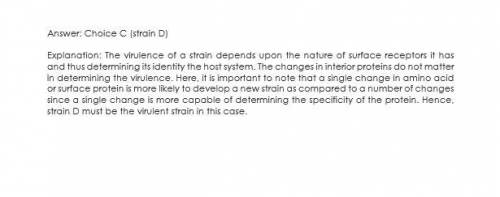
Biology, 08.01.2020 00:31 maksims32592
Suppose you are a researcher in an influenza lab and your team has uncovered four strains that have evolved changes from last year’s influenza virus. strain a has evolved four changes in its surface proteins and three changes in its interior proteins. strain b has evolved two changes in its surface proteins and seven changes in its interior proteins. strain c has evolved six changes in its surface proteins and none in its interior proteins. strain d has evolved only a single change in its surface proteins and none in its interior proteins. assuming that all other factors are equal, which strain is most likely to be infectious?

Answers: 2


Another question on Biology

Biology, 22.06.2019 00:30
Imagine that certain laws of physics could be ignored and you were able to travel vast distances in moments. now imagine that you traveled to an earth-like planet located light-years away that is known to support life. think about what you’ve learned in this unit and make an argument for what you think would be the dominant type of life form on this planet. consider whether a notochord is required for an organism to manipulate its environment and become a dominant creature.
Answers: 3

Biology, 22.06.2019 02:00
Bisphenol a (often called bpa) is a chemical found in products that people use every day, from water bottles to food containers to children's toys. unfortunately, bpa leaches out of its many products and makes its way into our bodies. what are the health effects of bpa exposure? ongoing research is finding that elevated exposure to bpa can affect a wide variety of developmental and physiological processes, but one of the first studies of bpa's health effects came about because of a simple mistake in the lab. at a laboratory at case western reserve university in 1998, geneticist patricia hunt was making a routine check of her female lab mice. as she extracted and examined developing eggs from the ovaries, she began to wonder what had gone wrong. she noticed that many of the eggs showed problems with their chromosomes, and some had irregular amounts of genetic material, which can lead to miscarriages and birth defects in mammals. she learned that a lab assistant had mistakenly washed the plastic mouse cages and water bottles with a harsh soap, releasing bpa from the plastic. knowing that bpa is an endocrine disruptor, a chemical that can enter organisms and mimic hormones, hunt set out to discover whether it had adversely affected her mice.
Answers: 2


Biology, 22.06.2019 10:00
What processes would you expect to be key in the production of yogurt ?
Answers: 1
You know the right answer?
Suppose you are a researcher in an influenza lab and your team has uncovered four strains that have...
Questions




Mathematics, 03.07.2020 19:01



Mathematics, 03.07.2020 19:01


Mathematics, 03.07.2020 19:01





Mathematics, 03.07.2020 19:01


Mathematics, 03.07.2020 19:01

Computers and Technology, 03.07.2020 19:01






